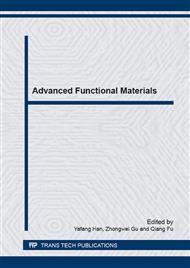p.176
p.183
p.188
p.194
p.199
p.207
p.211
p.217
p.222
Synchronous Characterization of Self-Bias Magnetoelectric Composite Materials
Abstract:
To investigate the mechanism of self-bias magnetoelectric effect in magnetoelectric composite materials, a synchronous characterization technique was developed to characterize the magnetoelectric effect, the magnetostrictive effect, and the magnetic hysteresis loop by one-time test. The results of a magnetoelectric composite consisting of hybrid ferromagnetic phases showed that the obvious magnetoelectric hysteresis behavior was found with significant self-bias magnetoelectric effect. In addition, after demagnetizing, the residual magnetic polarization became zero and the magnetoelectric effect disappeared at the same time. Since the ferromagnetic phases were separated from each other, the mechanism of self-bias magnetoelectric effect mainly resulted from static magnetic coupling instead of build-in magnetic field. It was concluded that the synchronous characterizing technique was quite helpful when analyzing the mechanism of magnetoelectric behavior.
Info:
Periodical:
Pages:
199-203
Citation:
Online since:
March 2015
Authors:
Price:
Сopyright:
© 2015 Trans Tech Publications Ltd. All Rights Reserved
Share:
Citation:


